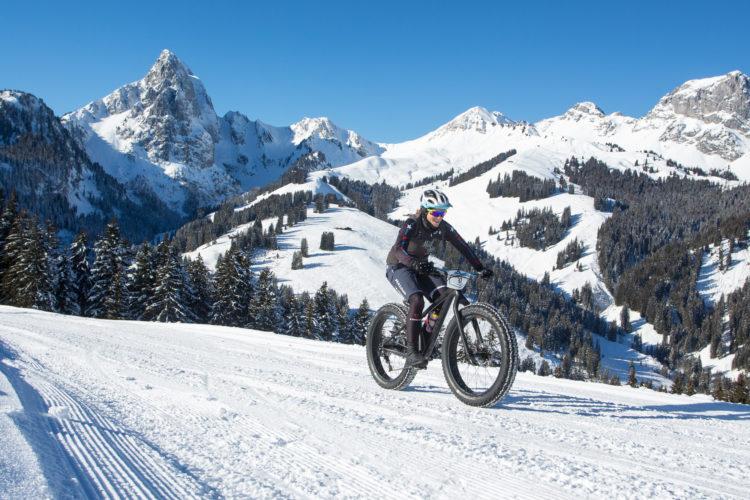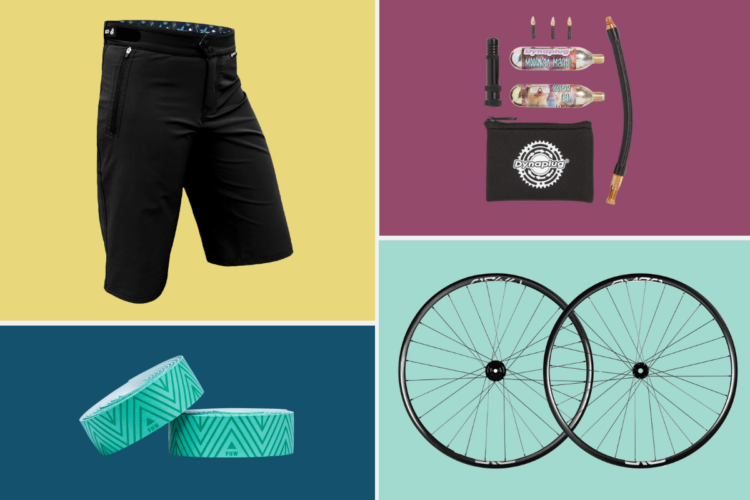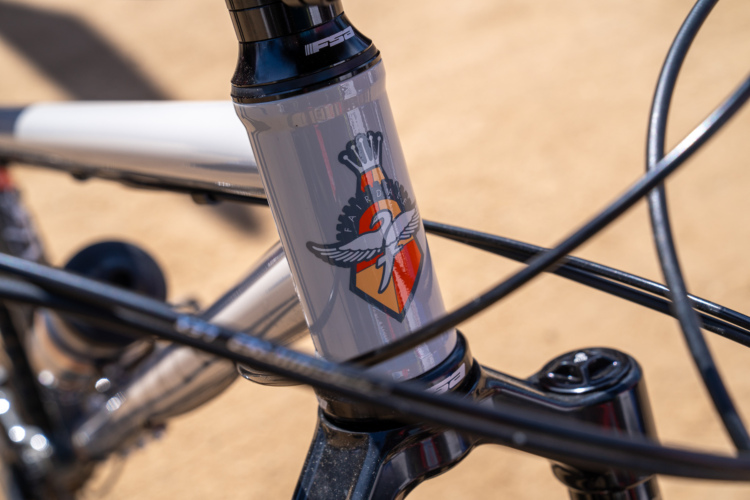
It’s common for business owners to hide their personal politics from the face of their brands, as they don’t want to estrange some segment of their clientele who don’t agree with their political philosophies. They might donate to causes they care about, but they’re not going to post about it on their media channels. Many hope to appear neutral and objective, despite the unavoidable political leanings that determine their business policies and procedures.
On the flip, there are companies like Vermont’s SDR Clothing that display their political and social stance proudly, and choose to use whatever power and influence they have to promote the things they care about. They put their money where their mouth is, and aren’t afraid to voice support for inclusivity and justice. Colin Burch is the owner and “crew” behind SDR Clothing, and the bearded artist pulls no punches when it comes to fighting for a better mountain bike community for everyone. His punk and hardcore roots no doubt play a major role in his focus on diversifying the sport and equally supporting people throughout the communities that he works with.
Here is a little of the story behind SDR Clothing Company, and the creative shredder who makes it all happen.

What inspired you to start an MTB apparel company? How long have you been running SDR?
It was kind of an accident really. In 2014 I started SDR in Pittsburgh, PA as a cyclocross team sponsored by my graphic design company that was built around my wife and an old buddy from my bike messenger days. We added some other bike punks, messenger friends, and friends from the mountain bike world who were interested in trying cyclocross. People really liked the jerseys and the merch designs I made for the team so I started making a few more designs. The second year, my wife really lost interest in racing and instead I put together a small team of riders who were focused on downhill, freeride, dual slalom, and dirt jumping/BMX. By the third year I decided I couldn’t run a team AND a clothing brand by myself so I focused on the clothes and just riding and building trails for the love of it. This year I was actually getting back to the racing roots and fielding a team of absolute ripper groms in the largest enduro and downhill series on the east coast, but that was before the pandemic threw everything into chaos. Hopefully we still get to see some racing once things are safe again!
What does SDR stand for?
Scurvy Dogs Racing. It was just a dumb joke name because we were a privateer race team (and there are only so many pirate puns you can make in Pittsburgh without everyone assuming you’re referencing the local Major League Baseball team). As SDR grew and took on a life of its own I went through a few variations on the name and branding until I settled on SDR Clothing Company. As with most things I do, it’s mostly out of sheer stubbornness and a complete lack of any sort of a real plan that it wound up this way.
When did you first start mountain biking?
I rode in the woods occasionally here and there for a decade starting in the mid-90s, but got much more serious about it in 2005 when my roommate got severely injured on the job as a bike messenger and we started riding in the woods a lot more after he had recovered enough. Soon we started a sort of punk-rock MTB club with our good friend out of his BMX fabrication shop, that was slowly turning into a full service bike shop. Disgruntled Off-Road Cyclists or DORC and Thick Bikes were kind of the center of my social universe for a good chunk of time, and also responsible for introducing me to downhill and freeride when we took a group trip to Snowshoe Bike Park in 2007. I’ve been absolutely hooked on gravity riding ever since.

Are most of your sales in custom gear or more so the products on your site?
Traditionally my retail line has made up most or all of my sales, although the custom dye-sub apparel has really taken off in the last year and now with the pandemic canceling or postponing the races and events where I made the majority of my retail sales, things are evening out a lot more.
You partner with the Eastern States Cup, Cycling Industry Pledge, VMBA, and Pride Rides Vermont. What are some of the ways you work with those organizations toward community building and support?
It varies from group to group. With Eastern States Cup I came on board as a series sponsor because they were one of the first series offering equal prize money to the men’s and women’s podiums. To encourage more folks to try racing and help defer some of the cost for amateurs, I sponsor the SDR Podium Rewards which offers a cash prize to the top three folks on the podium in any amateur men’s class with at least 50 entries and any amateur women’s class with at least 20 entries.
With the Cycling Industry Pledge, I try to lead by example and encourage the larger companies I work with to learn about the principles and join the pledge. I also make abiding by the pledge and the WTF Bikexplorers Guiding Principles a condition of any team or individual sponsorship I offer. Additionally, I have reserved team sponsorships for junior development teams and teams dedicated to serving marginalized groups in MTB and I have reserved all my individual rider sponsorships for WTF, BIPOC and LGBTQAI+ riders.
With VMBA I am an active business sponsor, along with being an active member of 7 chapters (and an additional 2 IMBA clubs across the lake in the Adirondack Mountains of New York) and I participate in fundraisers, trail days, and member meetings with an emphasis on supporting diversity and inclusion initiatives regionally and with my local chapters. Pride Rides Vermont is a grass roots project started by my good friend Kris, who was actually the very first Vermont rider SDR ever sponsored. I try to attend as many of their group rides as possible along with doing fundraisers to support the work and being an advocate for my friends at a personal level.

Your “Anarchy, Equality, Gravity” shirts that featured the transgender flag backdrop are what first caught my attention. How has your emphasis on broader community support been received by the larger MTB community?
It’s been mostly positive. There are always a few retrograde idiots out there who fight against any sort of change that might threaten their privilege, but those aren’t my people, and I honestly don’t care if they like me or buy anything from me. I’m not trying to be the next RaceFace or Dakine or Fox or any other mass-market bike brand out there. I come from the 90s punk and hardcore scene and all the leftist politics that go with it. That shapes my world view more than anything else and I look at SDR as my punk band. If I can’t say what I think is right and support the causes I care about, why even bother? I made way more money and had way more free time when I was working as a web designer. This is a passion project above all else, and that’s what guides me.
I come from the 90s punk and hardcore scene and all the leftist politics that go with it. That shapes my world view more than anything else and I look at SDR as my punk band. If I can’t say what I think is right and support the causes I care about, why even bother?
SDR makes a fairly wide variety of chillin’ and riding apparel. Do you have plans to branch out into protection or other gear at any point?
Short term, no. The main goal for production is to bring the dye-sub work as in-house and regional as possible while keeping prices at what I think is a reasonable place. Long term? I’d love to make shorts eventually. As a larger rider and a cranky old curmudgeon, I have some very specific ideas about what makes a good pair of riding shorts.

Where are your garments made?
Thats been an evolving thing, and as I have more resources and learn more I’ve been bringing things closer and closer to home. Right now there are a few sources. All the custom dye-sub gear comes from my factory partner in Beijing. Eventually I am hoping to be able to invest in my own dye-sub fabric printing in-house and move the cut and sew to regional contract sewers here in the northeast. All the casual wear and outer wear are sourced from two industry leaders for blank garments. All the cotton/cotton blend stuff (hoodies, tees, etc) is manufactured either in the US entirely or in North and Central American factories from US materials (all the fabric dying is actually done in California) and the outerwear is made in a combination of Asian and South and Central American factories.
I’d love to move everything to regional union labor shops, but it’s just not feasible for someone as small as me where I’m often doing 10-20 total items in a production run. I am proud to say, however, that the companies I source from are sweatshop-free and all their facilities are Platinum WRAP certified for labor and human rights.
Where and when did you learn to screenprint?
I learned to print and do the pre-press work back in my high school graphics lab (huge thanks to my teacher Ron Hindmarch). I always did a bit of printing here and there through art school and when I started out in interactive/graphic design and actually managed the custom printing shop for a now-defunct lacrosse supply company for a year or so after the bottom fell out of the tech startup I was at in the early 2000s. I also want to give thanks to my friends at Ink Division in Pittsburgh. They did all my printing when I first started SDR and helped me immensely with advice and practical issues when I started bringing the printing in-house. Solid folks there, and great printers.

What’s the best thing about living in Vermont? The worst?
It’s a tie between the amazing landscape and the sense of community that exists here in the MTB scene and the larger culture. The worst thing is probably the lack of racial and ethnic diversity. Vermont is a very special place, but there’s just no getting around the fact that its overwhelmingly white. I am lucky in that we live in the most ethnically diverse part of the state (Burlington/Winooski). Hopefully the outdoor sports community can play a real part in welcoming more folks here, creating a more diverse and inclusive community.
What is your favorite local trail or system?
I cant really pick just one. We have an embarrassment of riches when it comes to trails in this area. My top picks, in no particular order would be Perry Hill in Waterbury, Bolton Valley, Millstone Trails in Websterville, Sleepy Hollow Inn in Huntingdon and the entire Richmond Mountain Trails network in Richmond.

What do you think is the best way to promote equality in our sport and/or industry?
Use what privilege and platform you have to push back against the stupid bullshit you encounter every day in cycling. Be the person who stands up and says that homophobic or racist or transphobic or misogynistic joke isn’t acceptable. Be willing to call out your riding buddies for doing things on a group ride that make others feel unwelcome, [and] call your friends out for making shitty comments on social media. Make it socially unacceptable to be a bigoted asshole. Elevate and center the voices of marginalized folks in the cycling world, they don’t need anyone to speak for them, but they need us to make room for them to speak and be heard. Follow and support the folks doing the work. Here are a few great Instagram accounts to follow to get you started: @wtfbikexplorers, @cyclista_zine, @pedal2thepeople, @allmountainbrothers, @decolonizing_fitness, @badgal_brooky, @ayesuppose, @sisumagazine
What are some cool plant and animal species you see alongside trails where you live?
Typical northeastern forest animals. Lots of birds; eagles, hawks, owls, grouse, woodpeckers, crows, and ravens along with all the little songbirds you never really see. Tons of chipmunks, a few deer here and there, porcupines, beavers, and the occasional moose or black bear. I’m not so good with identifying plants but lots of ferns and wildflowers (trilliums, forget me not, lilacs, salvia, day lilies, etc) and the trees are a mix of mostly pines, oak, walnut, beech, ash and of course maple with the occasional stand of white birch.




















